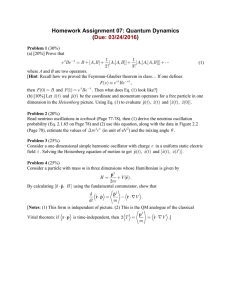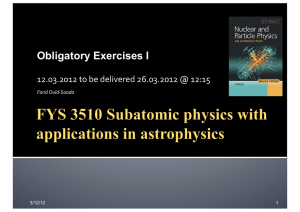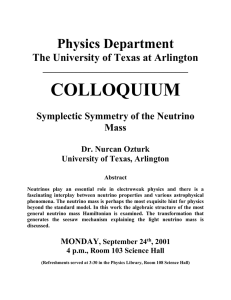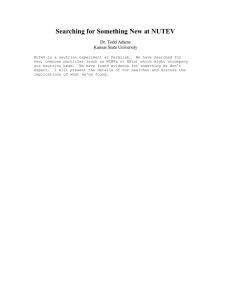Tsung Dao Lee - Nobel Lecture
advertisement
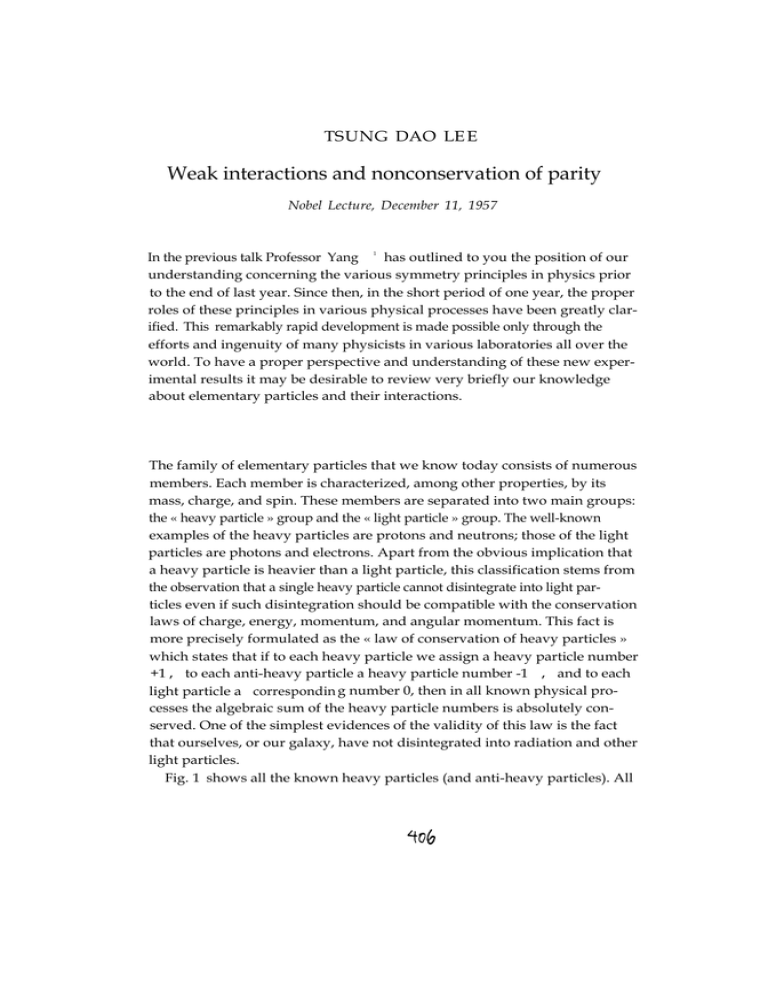
TSUNG DAO LE E
Weak interactions and nonconservation of parity
Nobel Lecture, December 11, 1957
In the previous talk Professor Yang 1 has outlined to you the position of our
understanding concerning the various symmetry principles in physics prior
to the end of last year. Since then, in the short period of one year, the proper
roles of these principles in various physical processes have been greatly clarified. This remarkably rapid development is made possible only through the
efforts and ingenuity of many physicists in various laboratories all over the
world. To have a proper perspective and understanding of these new experimental results it may be desirable to review very briefly our knowledge
about elementary particles and their interactions.
The family of elementary particles that we know today consists of numerous
members. Each member is characterized, among other properties, by its
mass, charge, and spin. These members are separated into two main groups:
the « heavy particle » group and the « light particle » group. The well-known
examples of the heavy particles are protons and neutrons; those of the light
particles are photons and electrons. Apart from the obvious implication that
a heavy particle is heavier than a light particle, this classification stems from
the observation that a single heavy particle cannot disintegrate into light particles even if such disintegration should be compatible with the conservation
laws of charge, energy, momentum, and angular momentum. This fact is
more precisely formulated as the « law of conservation of heavy particles »
which states that if to each heavy particle we assign a heavy particle number
+1 , to each anti-heavy particle a heavy particle number -1 , and to each
light particle a correspondin g number 0, then in all known physical processes the algebraic sum of the heavy particle numbers is absolutely conserved. One of the simplest evidences of the validity of this law is the fact
that ourselves, or our galaxy, have not disintegrated into radiation and other
light particles.
Fig. 1 shows all the known heavy particles (and anti-heavy particles). All
WEAK INTERACTIONS AND PARIT Y
407
Fig. 1.
heavy particles except the nucleons are called hyperons and are labelled by
capital Greek letters. The solid lines represent particles that are expected to
exist from general theoretical arguments. All known heavy particles have
half-integral spins. Fig. 2 shows all the known light particles. Among these,
the e ±, µ± and ν, Y have half-integral spins. They are called leptons. The rest,
photons, pions and K mesons, have integral spins.
The interactions (not including the gravitational forces) between these particles can be classified into three distinct groups:
1. Strong Interactions. This group is responsible for the production and the
scattering of nucleons, pions, hyperons (i.e. rl”, 2, etc.) and K mesons. It is
characterized by a coupling constant.f2/fic z I.
2. Electromagnetic Interactions. The electromagnetic coupling constant is ( e2/
gC> = ( 1 / 1 3 7 ) .
3. Weak Interactions. This group includes all known non-electromagnetic decay interactions of these elementary particles and the recently observed ab2
sorption process of neutrinoes by nucleons . These interactions are characterized by coupling constants gz/Ac r 10-14.
1957 T.D.LE E
Y
Fig. 2.
The law of conservation of parity is valid for both the strong and the electromagnetic interactions but is not valid for the weak interactions. Today’s
discussions will be mainly on the recently observed effects of nonconservation of parity in the various weak interactions.
II
The weak interactions cover a large variety of reactions. At present there are
about 20 known phenomenologically independent reactions ranging from
the decay of various hyperons to the decay of light particles. Within the last
year, many critical experiments have been performed to test the validity of
the law of conservation of parity in these reactions. We shall first summarize
the experimental results together with their direct theoretical implications.
Next, we shall discuss some further possible consequences and theoretical
considerations.
WEAK INTERACTIONS AND PARIT Y
Mirror
409
reflection
Fig. 3.
(1 ) p-decdy
The first experiment that conclusively established the nonconservation of
parity was that on β-angular distribution from polarized 6OCo nuclei 3 (see
Fig. 3). The 60Co nuclei are polarized by a magnetic field at very low temperatures. Indeed in this experiment, the circular direction of the electric
current in the solenoid that produces the polarizing magnetic field together
with the preferential direction of the p-ray emitted, differentiates in a most
direct way a right-handed system from a left-handed system. Thus the nonconservation of parity or the non-invariance under a mirror reflection can be
established without reference to any theory.
Furthermore from the large amount of angular asymmetry observed it
4
can also be established that the ,&decay interaction is not invariant under a
charge conjugation operation. That this can be concluded without performing the extremely difficult (in fact, almost impossible) experiment using
anti-60Co is based on certain theoretical deductions under the general framework of local field theory. In the following we shall try to sketch this type
5
of reasoning .
Let us consider the β-decay process, say
n-+p+e-+v
(1)
in which each particle is described by a quantized wave equation. In partic6
ular the neutrino is described by the Dirac equation
410
1957 T.D.LEE
where yI, yz, y3, y4, are the four (4 × 4) anti-commuting Dirac matrices and
xi, x2, x3, x4 = ict are the four space-time coordinates. For each given momentum there exists two spin states for the neutrino and two spin states for
the anti-neutrino. These may be denoted by
vR, v=, GR, GP If we define the
helicity H to be
with Gas the spin operator and $ the unit vector along the momentum direction, then these four states have, respectively, helicities equal to
+ I, - I,
- I a n d + I (Fig. 4). M athematically, this decomposition of states corresponds to a separation of yV into a right-handed part yR and a left-handed
part vL with
YY = Y’R + YL
(4)
where
V’V
(5)
YL=+(I+Yj)%
(6)
and
Ys = YIYZY3Y4
YR=~('-?j)
It is easy to see that both yR and yL separately satisfy the Dirac equation
t s d ecomposition the β process of a nucleus A can be rep[Eq. (2)]. With hi
resented schematically as
Fig. 4.
WEAK INTERACTIONS AND PARIT Y
411
with CS and Cf as the various probability amplitudes for emission of
vR and
vL respectively. The suffix i represents the various possible channels for such
emissions. If the theory is invariant under proper Lorentz transformation,
then there are five such channels: namely scalar S, tensor T, vector V,
pseudo-scalar P and axial-vector term A. According to the general rules of
quantum field theory with any interaction term representing the decay of a
particle, there exists a corresponding hermitian conjugate term which represents decay of the antiparticle. Thus, the decay of the anti-nucleus A can
be schematically represented by
A + E + c+ +
CR* Y
( H = -I )
($* -R
z vL (H=+I)
(7’)
(8’)
with CiF* and Cf* as the corresponding amplitudes for emission of YR and
GL. Under the charge conjugation operator we change a particle to its antiparticle but we do not change its spatial or spin wave functions. Consequently it must have the same helicity. Thus, if the β-decay process is invariant under the charge conjugation operator, then we should expect process (7) to proceed with the same amplitude as process (8’). The condition
for invariance under charge conjugation is, then
C”z = CL”
z
(9)
for all i = S, T, V, P, A.
In the decay of 60Co, because there is a difference of spin values between
6O
Co and 60Ni, only the terms i = T and i = A contribute. From the large
angular-asymmetry observed it can be safely concluded that for bot
h i=
T, A
KR! * lc:l
which contradicts Eq. (9 ) and proves the non-invariance of β-interaction
under charge conjugation. For illustration purposes, we assume in the above
the neutrino to be described by a 4-component theory and further we assume
that in the p-decay process only neutrino is emitted. Actually the same conclusion concerning the non-invariance property under charge conjugation
can be obtained even if the neutrino should be described by a, say, 8-component theory, or, if in addition to neutrino, anti-neutrino may also be
emitted.
412
1957 T.D.LE E
Recently many more experiments have been performed on the longitudinal polarization of electrons and positrons, th e β−γ, correlation together
with the circular polarization of the γ radiation and the β angular distribution with various polarized nuclei other than 60Co. The results of all these
experiments confirm the main conclusions of the first 60Co experiment, that
both the parity operator and the charge conjugation operator are not conserved in β-decay processes.
Another interesting question is whether the
β-decay interaction is invariant
under the product operation of (charge conjugation
x mirror reflection).
Under such an operation we should compare the decay of A with that of A
but with opposite helicities. Thus if
β-decay is invariant under the joint
operation of (charge conjugation x minor reflection) we should expect process (7) to proceed with the same amplitude as process (7’) and similarly for
processes (8) and (8’). T he corresponding conditions are then
7
CP zzz cc*
a n d CiL = Ci*
(10)
Although experiments have been performed to test the validity of these conditions, at present, these experiments have not reached a conclusive stage and
we still do not know the answer to this important question.
(2) z-p-e d e c a y
The π± meson decays into a µ ± meson and a neutrino. The
µ ± meson, in
±
turn, decays into an e and two neutrinoes (or anti-neutrinoes). If parity is
not conserved in π-decay, the µ meson emitted could be longitudinally po-
Fig. 5.
WEAK INTERACTIONS AND PARITY
413
larized. If in the subsequent pdecay parity is also not conserved, the electron
(or positron) emitted from such a ,u meson at rest would in general exhibit a
forward and backward angular asymmetry with respect to the polarization
of p meson (Fig. 5). Consequently in the z-p-e decay sequence we may observe an angular correlation between the momentum of,& meson measured
in the rest system of ,z meson and the momentum of ei measured in the rest
system of ,&. If this angular correlation shows a forward backward asymmetry, then parity must be nonconserved in both π-decay and ,u-decay. The
experimental results 8 on these angular correlations appeared within a few
days after the results on /?-decay were known. These results showed conclusively that not only parity is not conserved but the charge conjugation
operator is also not conserved in π-decay as well as in pdecay.
9
Later, direct measurements on the longitudinal polarization of the positron from p+-decay was done establishing the same conclusion concerning
µ -decay.
(3) K-p-e decay
In this case we have instead of the x meson the heavier K meson which decays into a p meson and a neutrino (Fig. 6). Experiment 10 on the angular
correlation between the ,u+ momentum from the decay of K + meson and the
positron momentum from the ,&decay establishes that in K-decay the parity as well as the charge conjugation operator is not conserved.
(4) Ilo-decay
The do particle can be produced by colliding an energetic 7~- on proton. The
Fig. 6.
414
1957 T.D.LE E
Fig. 7.
do subsequently decays into a proton plus a π− (Fig. 7). The observation of
Gout
an a symmetrical distribution with respect to the sign of the product
(Gin x gn) formed from the momentum of the incoming pion
Fin, the momentum of the lambda particle, p’,,,, and that of the decay pion &,t would
constitute an unequivocal proof that parity is not conserved in this decay.
11
Recent experiments on these reactions demonstrates that in these reactions
gout and (j& x 6,).
there is indeed such an angular correlation between
Furthermore, from the amount of the large up-down asymmetry it can be
concluded that the Λο-decay interaction is also not invariant under the
charge conjugation operation.
From all these results it appears that the property of nonconservation of
parity in the variou s weak interactions and the noninvariance property of
these interactions under charge conjugation are well established. In connection with these properties we find an entirely new and rich domain of natural phenomena which, in turn, gives us new tools to probe further into the
structure of our physical world. These interactions offer us natural ways to
polarize and to analyze the spins of various elementary particles. Thus, for
example, the magnetic moment of the µ meson can now be measured to an
extremely high degree of accuracy 12 which, otherwise, would be unattain-
WEAK INTERACTIONS AND PARIT Y
415
13
able; the spins of some hyperons now may perhaps be determined
unambiguously through the observed angular asymmetries in their decays; new
aspects of the electromagnetic fields of various gas, liquid and solid materials
can now be studied by using these unstable, polarized particles. However,
perhaps the most significant consequences are the opening of new possibilities and the re-examination of our old concepts concerning the structure of
elementary particles. We shall next discuss two such considerations - the twocomponent theory of neutrino, and the possible existence of a law of conservation of leptons.
III
Before the recent developments on nonconservation of parity, it was customary to describe the neutrino by a four-component theory in which, as
we mentioned before, to each definite momentum there are the two spin
states of the neutrino vR and vL, plus the two spin states of the antineutrino
YR and GL. In the two-component theory, however, we assume two of these
states, say, vL and GL simply do not exist in nature. The spin of the neutrino
is then always parallel to its momentum while the spin of the antineutrino is
always antiparallel to its momentum. Thus in the two-component theory
we have only half of the degrees of freedom as in the four-component theory. Graphically we may represent the spin and the velocity of the neutrino
by the spiral motion of a right-handed screw and that of the antineutrino by
the motion of a left-handed screw (Fig. 8).
The possibility of a two-component relativistic theory of a spin ½ particle
was first discussed by H. Weyl 14 as early as 1929. However, in the past, because parity is not manifestly conserved in the Weyl formalism, it was always
rejected 1 5. With the recent discoveries such an objection becomes completely invalid 16.
To appreciate the simplicity of this two-component theory in the present
situation it is best if we assume further the existence of a conservation law
for leptons 17. This law is in close analogy with the corresponding conservation law for the heavy particles. We assign to each lepton a leptonic number l equal to + 1 or - 1 and to any other particle the leptonic number
zero. The leptonic number for a lepton must be the negative of that for its
antiparticle. The law of conservation of leptons then states that « in all
physical processes the algebraic sum of leptonic numbers must be conserved ».
416
1957 T.D.LE E
Some simple consequences follow immediately if we assume that this law
is valid and that the neutrino is described by the two-component theory.
(I) The mass of the neutrino and the antineutrino must be zero. This is true
for the physical mass even with the inclusion of all interactions. To see this
let us consider a neutrino moving with a finite momentum. From the twocomponent theory the spin of this neutrino must be parallel to its momentum. Suppose now it has a non-vanishing physical mass. Then, we can always
send an observer travelling along the same direction as the neutrino but with
a velocity faster than that of the neutrino. From this observer’s point of view
this « neutrino » now becomes a particle with the spin along its original direction but the direction of momentum reversed; i.e. it becomes an « antineutrino». However since the leptonic number for neutrino is different from
that of the antineutrino, these two particles cannot be transformed into each
other by a Lorentz transformation. Consequently, the physical mass of a
neutrino must be zero.
(2) The theory is not invariant under the parity operator P which by definition inverts all spatial coordinates but does not change a particle into its
antiparticle state. Under such an operation one inverts the momentum of a
particle but not its spin direction. Since in this theory these two are always
parallel for a neutrino, the parity operator P applied to a neutrino state leads
to a non-existing state. Consequently the theory is not invariant under the
parity operation.
(3) Similarly one can show the theory is not invariant under the charge conjugation operation which changes a particle into its antiparticle but not its
spin direction or its momentum.
To test the complete validity of the conservation law of leptons and the
WEAK INTERACTIONS AND PARIT Y
417
two-component theory we have to investigate in detail all the neutrino processes. For example in p-decay we must have either
or
n+p+e-+~(H,=+I)
n-+pfe-+Y(HF=-~)
This can be determined by measuring the spin and the momentum of the
neutral lepton; i.e. to see whether it is a neutrino (right-handed helicity) or
an antineutrino (left-handed helicity). Through the law of conservation of
angular momentum, measurements on polarizations and angular distributions of the nucleus and the electrons can lead to determination of the spin
states of the neutrino. Similarly, through the recoil momentum measurements we can find out information about the linear momentum of the neutrino. In the same way we can use not only β-decay but π-decay, µ-decay
and K-decay to test the validity of either the two-component theory or the
law of conservation of leptons. At present, these measurements have not yet
reached a definitive stage. Much of our future may depend on the results of
these experiments.
IV
The progress of science has always been the result of a close interplay between our concepts of the universe and our observations on nature. The former can only evolve out of the latter and yet the latter is also conditioned
greatly by the former. Thus in our exploration of nature, the interplay between our concepts and our observations may sometimes lead to totally unexpected aspects among already familiar phenomena. As in the present case,
these hidden properties are usually revealed only through a fundamental
change in our basic concept concerning the principles that underly natural
phenomena. While all this is well-known, it is nevertheless an extremely
rich and memorable experience to be able to watch at close proximity in a
single instance the mutual influence and the subsequent growth of these two
factors - the concept and the observation. It is, indeed, a privilege that I am
able to tell you part of this experience in the recent developments concerning
the nonconservation of parity and the weak interactions.
418
1957 T.D.LEE
1. C. N. Yang, Nobel Lecture, this volume, p. 393.
2. C. L. Cowan, Jr., F. Rines, F. B. Harrison, H. W. Kruse, and A. D. McGuire,
Science, 124 (1956) 103.
3. C. S. Wu, E. Ambler, R. W. Hayward, D. D. Hoppes, and R. P. Hudson,
Phys.
Rev., 105 (1957) 1413.
4. T. D. Lee, R. Oehme, and C. N. Yang, Phys. Rev., 106 (1957) 340; B. L. Ioffe, L.
B. Okun, and A. P. Rudik, J.E.T.P. (U.S.S.R.), 32 (1957) 396.
5. We remark here that if the neutrino is described by a two-component theory (see
Section III) then the result of the large angular asymmetry in 60Co decay establishes in a trivial way the non-Invariance property of β-decay under the charge
conjugation operation. However, this non-invariance property can also be proved
under a much wider framework. In this section we take as an example the case of
a four-component theory of neutrino to illustrate such a proof
6. For notations and definitions of γ matrices see, e.g., W. Pauli, Handbuch der Physik,
Julius Springer Verlag, Berlin, 1933, Vol. 24.
7. For a summary of these experiments see, e.g., Proceedings of the Seventh Annual
Rochester Conference, Interscience, New York, 1957.
8. R. L. Garwin, L. M. Lederman, and M. Weinrich,
Phys. Rev., 105 (1957) 1415 ;
J. I. Friedman and V. L. Telegdi, Phys. Rev., 105 (1957) 1681.
9. G. Culligan, S. G. F. Frank, J. R. Holt, J. C. Kluyver, and T. Massam, Nature, 180
(1957) 751.
10. C. A. Coombes, B. Cork, W. Galbraith, G. R. Lambertson, and W. A. Wenzel,
Phys. Rev., 108 (1957) 1348.
11. J. Crawford, et. al., Phys. Rev., 108 (1957) 1102; F. Eisler et al., Phys. Rev., 108
(1957) 1353; R. Adair and L. Leipuner, Phys. Rev., (to be published).
12. T. Coffin, R. L. Garwin, L. M. Lederman, S. Penman, and A. M. Sachs,
Phys.
Rev., 107 (1957) 1108.
13. T. D. Lee and C. N. Yang, Phys. Rev., 109 (1958) 1755.
14. H. Weyl, Z. Physik, 56 (1929) 330.
15. Cf. W. Pauli, Handbuch der Physik, Julius Springer Verlag, Berlin, 1933, Vol. 24,
pp. 226-227.
16. The possible use of a two-component theory for expressing the nonconservation
property of parity in neutrino processes was independently proposed and discussed by T. D. Lee and C. N. Yang,
Phys. Rev., 105 (1957) 1671; A. Salam,
Nuovo Cimento, 5 (1957) 299; and L. Landau, Nucl. Phys., 3 (1957) 127.
17. The possible existence of a conservation law for leptons has been discussed before
the discovery of nonconservation of parity. Cf. E. Konopinski and H. M. Mahmoud, Phys. Rev., 92 (1953) 1045.
